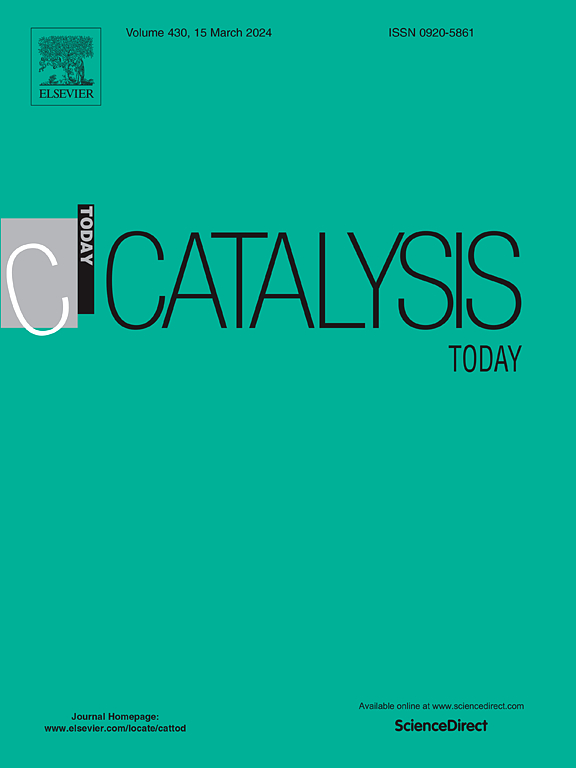Further synthetic investigation of YNU-5 zeolite and its application as a solid acid catalyst for the MTO reaction
IF 5.2
2区 化学
Q1 CHEMISTRY, APPLIED
引用次数: 0
Abstract
The synthesis conditions for YNU-5 zeolite were further optimized using dimethyldipropylammonium hydroxide as the organic structure-directing agent (OSDA). The use of FAU-type zeolite as the Si and Al source was essential for obtaining a high-quality YNU-5 samples, although the formation of the YFI framework was still possible without using the FAU-type zeolite. After removing the OSDA, the pure YNU-5 sample (denoted as YNU-5_cal), was converted to its proton form via ammonium ion exchange followed by calcination. YNU-5_cal was then treated with various concentrations of nitric acid under reflux conditions to obtain its dealuminated form with different Si/Al ratios while maintaining framework stability. During the investigation of the dealumination process, distinct dealumination tendencies were observed depending on the type of zeolite framework, specifically Beta, MSE, YFI, and CHA. The obtained samples were evaluated as catalysts for the methanol-to-olefin (MTO) reaction. In this reaction, YNU-5 catalysts with Si/Al ratios of 9–100 exhibited rapid deactivation due to heavy coking. In contrast, when the Si/Al ratio was as high as 200, deactivation was significantly suppressed. Notably, the regeneration of the deactivated catalyst was achievable when deactivation resulted from coking. The approximate location of acid sites within the framework was inferred based on dealumination behavior, NMR data, and the catalytic performance in the MTO reaction.
进一步研究了YNU-5沸石的合成及其作为MTO反应固体酸催化剂的应用
以二甲基二丙基氢氧化铵为有机定向剂(OSDA),进一步优化了YNU-5分子筛的合成条件。使用fau型沸石作为Si和Al源对于获得高质量的YNU-5样品至关重要,尽管不使用fau型沸石仍然可以形成YFI框架。除去OSDA后,经铵离子交换转化为质子形式的纯YNU-5样品(记为YNU-5_cal),然后煅烧。然后在回流条件下用不同浓度的硝酸处理YNU-5_cal,得到具有不同Si/Al比的脱铝形式,同时保持骨架稳定性。在脱铝过程的研究中,观察到不同分子筛骨架类型的脱铝倾向,特别是Beta、MSE、YFI和CHA。所得样品被评价为甲醇制烯烃(MTO)反应的催化剂。在此反应中,Si/Al比为9-100的YNU-5催化剂由于重度焦化而快速失活。相反,当Si/Al比高达200时,失活明显受到抑制。值得注意的是,当焦化导致失活时,失活催化剂的再生是可以实现的。根据脱铝行为、核磁共振数据和MTO反应的催化性能推断出框架内酸位的大致位置。
本文章由计算机程序翻译,如有差异,请以英文原文为准。
求助全文
约1分钟内获得全文
求助全文
来源期刊

Catalysis Today
化学-工程:化工
CiteScore
11.50
自引率
3.80%
发文量
573
审稿时长
2.9 months
期刊介绍:
Catalysis Today focuses on the rapid publication of original invited papers devoted to currently important topics in catalysis and related subjects. The journal only publishes special issues (Proposing a Catalysis Today Special Issue), each of which is supervised by Guest Editors who recruit individual papers and oversee the peer review process. Catalysis Today offers researchers in the field of catalysis in-depth overviews of topical issues.
Both fundamental and applied aspects of catalysis are covered. Subjects such as catalysis of immobilized organometallic and biocatalytic systems are welcome. Subjects related to catalysis such as experimental techniques, adsorption, process technology, synthesis, in situ characterization, computational, theoretical modeling, imaging and others are included if there is a clear relationship to catalysis.
 求助内容:
求助内容: 应助结果提醒方式:
应助结果提醒方式:


